Living and Working in Laxton
It is estimated from Domesday Book that Laxton may have been home to 120 people in 1086. The population was around 350 in 1635 and 425 in 1776. We know more about population after 1801 when the first census was taken and the population counted as 573. In 1821 there were 655 people living there, but by 1851 the population had declined to 534.
The inhabitants of Laxton are particularly well-documented after 1635, largely thanks to detailed record-keeping by the Thoresby estate agents. Mark Pierce's 1635 survey is the earliest list of landowners and tenants in the manor of Laxton, and enables us to plot exactly where they lived and worked. Later estate surveys in the Manvers collection can be used by researchers to see continuities and changes in the eighteenth and nineteenth centuries.
Estate papers such as inventories, correspondence and accounts illuminate aspects of the lives of villagers. The dominance of the Earls Manvers, who were the landlords of most inhabitants of Laxton in the nineteenth century, means that references to virtually all Laxton families in this period appear in the estate records.
The selection of material presented here does not include any of the historical documents housed at Nottinghamshire Archives. There is a mass of evidence for Laxton people held there including the parish registers, Poor Law records, taxation and rate records, wills and probate inventories, and records of local justice.
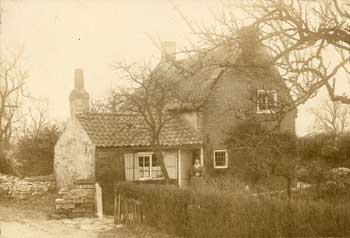
Photograph of Sarah Rose at Up Bar cottage, c.1890-1900 (MS 829/1)
Up Bar, the ancient lath and plaster thatched cottage, survived well into the twentieth century and was still inhabited by Johnnie Rose and his mother for several years in our childhood. It stood by the roadside, on the corner where ‘Shadow Lane’ joined ‘Up Bar’. There was a garden with fruit trees and the unfailing gooseberry bushes to be found in all the gardens of the village: but that cottage was not rebuilt when finally it fell into complete dereliction.
Edith Hickson, Life at Laxton c1880-1903: the childhood memories of Edith Hickson (Nottingham: Dept. of Adult Education, University of Nottingham, c.1983) East Midlands Collection Pamphlet Not 254.D28 HIC. pp.2-3
Sarah Rose (c.1814-1900) was the widow of Charles Rose, a bricklayer. Her cottage at Up Bar was occupied by Christopher Rose in 1789 and by Sarah’s father-in-law John Rose in 1820. Sarah’s grandson Elmar John Rose, known as Jack, was bailiff of the manor court in Laxton between 1936 and 1963.
Sarah’s letter (right) agreeing to a rent increase gives an idea of the fixtures in her cottage:
In the “house” - a cupboard, oven, boiler, grate and hearthstone.
In the “parlour” - a stove and grate.
In the “kitchen” - an oven, boiler, grate and sink-stone [a stone basin].
In the “yard” - a coal house, well, brandreth [gridiron or trivet], and a copper
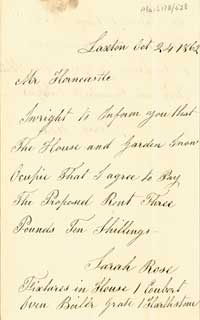
First page of letter from Sarah Rose describing her cottage, 1862
Manvers Collection Ma B 178/528
The Dovecote Inn was part of the Thoresby estate. A farmhouse on the present site was renovated as a public house in 1832. It remained a working farm as well as an inn until the 1960s.
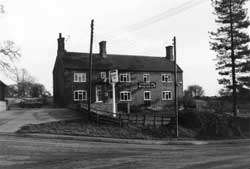
Photograph of the Dovecote Inn, Laxton, 1960s (from MS 829/4/11)
The Sun Inn was the oldest of four public houses in Laxton and Moorhouse and was situated on the main road, to the east of the parish church. Like the Dovecote Inn, it was a farm as well as a pub. The Sun Inn closed in 1876 on the orders of Earl Manvers, perhaps because there was not enough demand for four pubs in the parish.
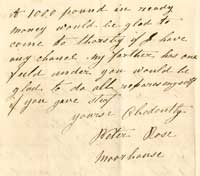
Part of a letter from Peter Rose applying to be tenant of the Dovecote Inn, 30 November 1874
Manvers Collection Ma B 189/1063
"Mr Horncastle,
Please sir I heare that the dovecoate inn is to let would be glad if you would give me a chance. I applied for it when Mr Motley had took it and your farther said he was sorry that I had not applied sooner he offered me one at the same time at Blythe. I ham 42 years of age has been on the Ossington eastate 30 years can have a recomandation from Mr Cann or Lady Ossington or any of the farmers. I have plenty of stok to bring and A 1000 pound in ready money would be glad to come to thorsby if I have any chance. My farther has one feild under you. Would be glad to do all repares myself if you gave stuf,
Yourse obedently
Peter Rose
Moorhouse"
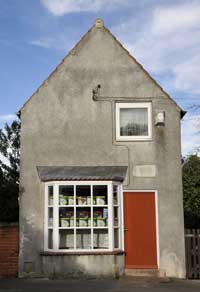 This Peter Rose was probably the son of Christopher Rose of Moorhouse, baptised in 1830. In 1874 he was keen to become a farmer and publican, but his request to Earl Manvers to become tenant of the Dovecote was not successful. In the 1881 and 1891 censuses he was working as a bricklayer. He could write, but was not very good at spelling.
This Peter Rose was probably the son of Christopher Rose of Moorhouse, baptised in 1830. In 1874 he was keen to become a farmer and publican, but his request to Earl Manvers to become tenant of the Dovecote was not successful. In the 1881 and 1891 censuses he was working as a bricklayer. He could write, but was not very good at spelling.
The general store dates back to the mid-nineteenth century, and remains open. Until 2008 it was also the Post Office. In the early twentieth century there were two shops in Laxton selling groceries and household items. Edith Hickson recalled that families also received deliveries from tradesmen at Tuxford. There was a large range of shops to visit in Tuxford, Retford or Newark.
An inventory, drawn up in 1903 when Samuel Laughton took the tenancy over from George Nettleship (Manvers Collection Ma 5E 143), gives an idea of the kind of items stocked in the general store. The second page of the inventory reveals that there was a bakehouse attached to the store.
More: The Court Leet and Common Land
Laxton: Farming in an Open Field Village home